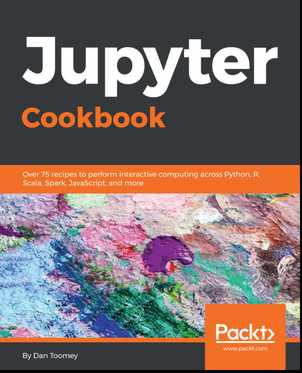| Jupyter Cookbook |
|
Author: Dan Toomey This is a collection of 75 recipes for Jupyter used with Python, R, Scala, Spark and JavaScript that aims to take developers from installing and running the Jupyter Notebook system through to working with big data. The book opens with the basics of installing and setting up Jupyter on Windows, Mac, Linux and a server. While many developers will find these recipes unnecessary, they are dealt with fairly quickly, and the author Dan Toomey then shows how to add various engines - Python 3, R, Julia, JavaScript, Scala and Spark, and in each case how to then run a script. The next few recipes show how to access and retrieve data in CSV, JSON, flat file, text and database files. From this point on the recipes become more useful, beginning with a chapter on visualizing your analytics. Tooney works through options in Python, R, and Julia, showing how to draw line graphs and histograms, generate regression lines using R, draw a Julia scatter diagram using Gadfly, and so on. The recipes usually start with a getting ready section, followed by instructions on how to do it and how it works. I found some of the explanations rather short, especially where the instructions say 'we can use this script' followed by a listing of a script without details of how you'd go about changing the script to use your own data or alter other aspects of the script to your own needs. However, so long as you know how to program in the particular language and are essentially looking for how to get things started with that combination of Jupyter and the particular language, you should be able to then work things out for yourself.
A chapter on working with widgets comes next, starting with an introduction to widgets in general and ipyleaftlet and ipywidgets. Toomey then shows how to use a widget container, interactive widgets, cookie cutter widgets and developing an OpenGL widget. Jupyter Dashboards are then introduced with recipes for creating dashboards for R, Python, Julia and JavaScript. A fairly lengthy chapter on sharing your code in various ways comes next, with recipes for doing so via a Notebook server, web server, via Docker, and nbviewer. There are also recipes for converting Notebooks to R, HTML, Markdown, reStructuredText, Latex and PDF. Toomey then moves on to multiuser Jupyter, showing recipes for JupyterHub, Docker, and running your Notebook in Google Cloud, AWS and Azure. Recipes for interacting with big data show how to work with big-text data sources to do simple things like get a word count, examine log file accesses, and analyze big text data to find combinations of two words. Making use of Jupyter security measures is the next topic to be considered. There are recipes looking at the built-in security measures, how to use SSL and the Jupyter trust model, along with a look at additional practices.The final chapter looks at using Jupyter Labs, and how this differs from previous versions of Jupyter. Conclusion There is some useful material in this book, and it serves as a good introduction to the various ways you can work with Jupyter. However, the recipes are best thought of as illustrations of the basics of how each of the combinations works together, rather than illustrating in-depth data analysis techniques. To be informed about new articles on I Programmer, sign up for our weekly newsletter, subscribe to the RSS feed and follow us on Twitter, Facebook or Linkedin.
|
|||
| Last Updated ( Wednesday, 08 August 2018 ) |

